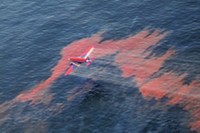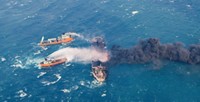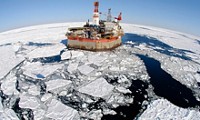Advertisement
Grab your lab coat. Let's get started
Welcome!
Welcome!
Create an account below to get 6 C&EN articles per month, receive newsletters and more - all free.
It seems this is your first time logging in online. Please enter the following information to continue.
As an ACS member you automatically get access to this site. All we need is few more details to create your reading experience.
Not you? Sign in with a different account.
Not you? Sign in with a different account.
ERROR 1
ERROR 1
ERROR 2
ERROR 2
ERROR 2
ERROR 2
ERROR 2
Password and Confirm password must match.
If you have an ACS member number, please enter it here so we can link this account to your membership. (optional)
ERROR 2
ACS values your privacy. By submitting your information, you are gaining access to C&EN and subscribing to our weekly newsletter. We use the information you provide to make your reading experience better, and we will never sell your data to third party members.
Environment
Drilling In An Arctic Frontier
Drifting ice, low water temperatures present unique problems for oil rigs in Alaska’s outer continental shelf
by Charles Schmidt
February 14, 2011
| A version of this story appeared in
Volume 89, Issue 7

Alaska’s outer continental shelf is a starkly beautiful ecosystem populated by polar bears, bowhead whales, and arctic seabirds. It’s also a bonanza for oil companies. Up to 23% of the oil and 21% of the natural gas remaining in the U.S. might be found there, according to government estimates. So despite the region’s fragile ecology and threats posed by extreme weather and icebergs, oil companies are vying for access.
Leading the pack is Royal Dutch Shell, which hopes to begin drilling exploratory wells in the outer continental shelf—specifically, the Beaufort Sea—in 2012.
But Shell’s plans have raised concerns among scientists and environmental groups, who wonder whether companies can extract the oil safely. They worry that the Arctic’s low water temperatures and drifting ice pose immense problems for spill cleanup.
Such concerns are reflected in the report released last month by the National Commission on the BP Deepwater Horizon Oil Spill & Offshore Drilling (C&EN, Jan. 24, page 24). In addition to the weather and ice problems, the report notes that drilling in this region is hampered by its remoteness: The nearest Coast Guard installation is 1,000 miles from proposed drilling areas. The report recommends more studies to ensure safety, but it adds: “The need for additional research should not be used as a de facto moratorium on activity in the Arctic.”
Similarly, a November 2010 report commissioned by the Pew Charitable Trusts concludes that drilling in the Arctic Ocean should only proceed after an assessment of how an oil company would respond to a spill and how the spill would affect the region’s ecosystems.
Curtis Smith, Shell’s spokesman in Anchorage, insists that drilling in the Arctic is safe. “We’ve been operating in the region for a long time without any significant problems,” he says. Since 1983, oil companies have drilled exploration wells at more than 65 sites in the Arctic Ocean without a major spill, according to the Pew report.
Six wells are currently operational in the Beaufort Sea, all seated on man-made gravel islands. Emergency crews could easily cap a blowout on these islands because the wellheads are above ground.
Shell’s proposed plan for the Beaufort site, however, is to drill from a floating platform in waters 150 feet deep, with a wellhead accessible only to divers and remotely controlled underwater vehicles. Just as in the Deepwater Horizon accident, underwater wellheads could make a spill response more challenging, says Richard Steiner, a conservation biologist in Alaska.
In any offshore Arctic spill scenario, ice is the major concern. Steiner says that the worst-case scenario would be a late-fall blowout, because crews would have difficulty containing it before the sea freezes over. “Oil would spread out under the ice; and there wouldn’t be much you could do about it until June,” he says.
For the proposed exploratory phase, Smith says that Shell would drill only during the open-water season, which generally lasts from July through September. The company monitors ice floes, he says, using satellites, radar, sonar, and visual observations.
Layla Hughes, an environmental attorney and senior program officer with the U.S. Arctic Program of the environmental group World Wildlife Fund, says the company’s permit application requests authorization to drill until the end of October, when ice is already forming. Smith responds that drilling operations could be halted “instantaneously” should ice become problematic. “The specific dates of operation don’t matter so much as the extent of ice cover,” he says.
Much as a frozen-over sea would hamper cleanup efforts, drifting ice could also cause problems. Research by industry and government groups has shown that ice can block, tear, or clog the booms and skimmers used in oil spill recovery.
Floating ice also would impede in situ burning, because it would trap oil beneath itself, according to the Pew report. And oil can spread via ice, Steiner says. Oil can become trapped in the cracks and crevices on the underside of pack ice, the large masses that break away from ice attached to shore. These chunks of ice can then spread the oil as they drift on ocean currents. When the ice melts, the oil releases into the water.
Ice could also interfere with dispersing the oil, another technique spill responders use to lessen oil’s impact on wildlife. In the Deepwater Horizon spill, a significant portion of the spilled oil ended up as microscopic droplets floating in the water column. Wave energy promotes this oil dispersion. But researchers have shown that extensive ice cover could disrupt dispersion by dampening wave energy, says B. Kenneth Trudel, a senior scientist with SL Ross Environmental Research, a consulting firm in Ottawa, Ontario. Even chemical dispersants—the mixtures of surfactants and solvents that cleanup crews spray onto oil slicks—need waves to work effectively, he adds.
Although Arctic ice could thwart dispersant use, the water’s low temperatures could actually help spill responders by slowing oil weathering. This is important because dispersants aren’t as effective on weathered oil—the dense, tarlike substance left behind after petroleum’s lighter components have dissolved away—in cold water, according to a study by the National Oil Spill Response Research & Renewable Energy Test Facility, a private contract lab.
However, the slow weathering due to low water temperatures could also have detrimental consequences on local ecology. Oil’s volatile components—benzene, toluene, ethylene, and xylene—are also its most toxic; the longer they linger in the sea before evaporating, the longer they exert their poisonous effects on wildlife, according to Joel E. Kostka, professor of biogeochemical oceanography at Florida State University.
Moreover, oil biodegrades more slowly in the Arctic Ocean than it does in warmer seas, says Ronald Atlas, professor of biology at the University of Louisville. “For every 10 °C decline in temperature, the rate of biodegradation decreases by a factor of two,” he says. An oil spill will take take four times as long to degrade in the Arctic, where sea temperatures hover around 5 to 10 °C, compared with the Gulf of Mexico, where water temperatures can average 25 °C, he says.
Kostka, who studies marine microbiology in Svalbard, a Norwegian archipelago inside the Arctic Circle, says that although some cold-loving microbes are unique to the Arctic, researchers have shown that many of the microbial species there are the same as those in the Gulf of Mexico. These microbes, such as Alcanivorax, oxidize petroleum hydrocarbons during respiration. “They just do it more slowly up there because respiration is a temperature-dependent enzymatic process,” Kostka says.
Given the many concerns about drilling in the Arctic, even its proponents admit that spill prevention would have to be a major consideration if offshore Arctic oil production is undertaken.
Shell says its planned oil spill response infrastructure is up to the task. But Chuck Clusen, director of national parks and Alaska projects at the Natural Resources Defense Council, an environmental group, points out that the Deepwater Horizon spill response involved thousands of vessels and tens of thousands of people deployed from a highly developed coastline. By contrast, Alaska’s northern plain has virtually no road system, no port facilities, and few airports, he says. No one knows what kind of damage a major spill might unleash. What’s certain, Clusen says, is that recovery from it would take a long time.





Join the conversation
Contact the reporter
Submit a Letter to the Editor for publication
Engage with us on Twitter